Lesbos, Chios and Samos
Bicycling and island hopping North Aegean Islands
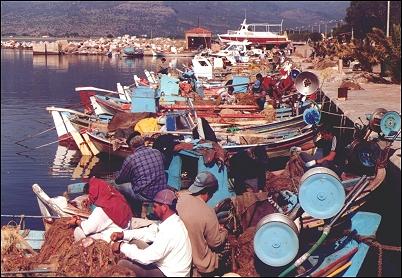
|
Lesbos, Chios and Samos are different enough from each other to make the trip varied. On Lesbos are wild and bare mountains, but green valleys. Molivos is a nice old town. On Chios the villages where mastic is produced haven't lost their medieval character. Samos is a very green island, and also crowded with tourists.
Travelogue & photos: Piet de Geus
Lesbos
Green valleys between wild, rocky mountains
When the door of the arrival hall opens at 11 PM, we immediately experience the strong wind that is so common on the Greek isles. Trees are bent, waves attack the beach. By the light of street lanterns we pass a fishing port and villas that lie scattered on a 500 meters high, green slope, on our way to Mitilini.
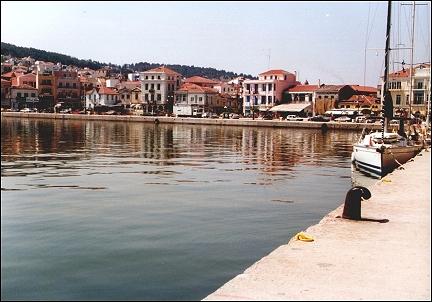 |
On Friday night everyone goes out: cars, motorcycles and mopeds form a traffic jam in front of overcrowded outdoor bars on the quay around the large, rectangular port. We are too late to find a private room or Bed and Breakfast; at none of the addresses around the bazar the doorbell is answered.
We have no choice but to find a room in a more expensive hotel by the ferry landing.
Mitilini is a nice town, but not more than that. Around the port are some pretty houses, and also in the narrow streets around bazar Ermou. There is an archeological museum and some churches are worth visiting if you're interested. Only a few stones remain of the Hellenistic theater and of the castle that hovers over the town only some walls still stand. The view there is wonderful, but that goes for every hilltop on Lesbos.
Immediately after breakfast we bicycle past the castle, the old port and a large ouzo distillery on the coastal road in northern direction. Panagiouda, the first village we pass, lies around a nice port. Pamfilla and Pirgi have some tower houses, but they are not as impressive as their colleagues on the Mani (Pelopponesos). We have coffee in Paralia, in an outdoor café with a view of the port.
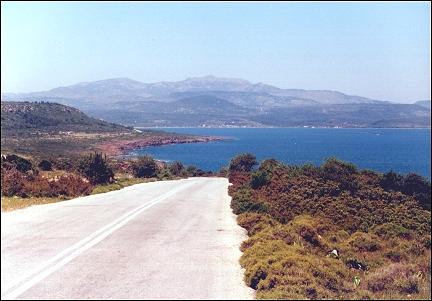 |
The coastal road has nasty hills. During the climb to Mistegna we are passed by two motorcyclists with yellow vests and a police car with flashing lights. A little later two bicycle racers struggle up the hill, followed by a large pack.
There are bicycle races on Lesbos this weekend, part of the Greek bicycle racing competition. All levels are included apparently, because hours later small groups of bikers still pass us.
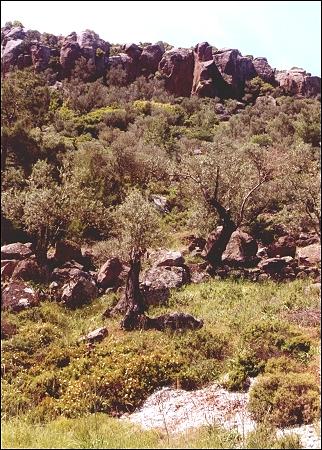 |
After we pass Kidonis, we leave the Bay of Xampelia behind us and are treated to a series of nasty hairpins. Once at the top, we have a great view of a group of islands, the coast of Turkey on the other side and the 968 meters high peak of the Lepetimnos Mountains, which we'll round later.
Just outside Mitilini the landscape was small scale, with lots of villages amidst citrus plantations, but now the surroundings are barren and wild. When we ride inland at Aspropotamos, we climb between bare rocks and olive trees. A little later we see Mandamados below us, in a valley in the foothills. We refresh ourselves with a drink in one of the pretty, narrow streets of this authentic village, with a view of a beautiful Byzantine church.
A little later Mandamados lies far below us, and in the distance behind it, we see the islands again. We pass Kapi, another mountain village with narrow cobblestone streets and houses built with rough rocks. Pelopi lies even higher, above a green valley with cypresses. The road meanders high above the slopes of the Lepetimnos via the still smaller hamlet of Ypsilometopo to Stipsi, a somewhat larger mountain village. These mountains are also popular with hikers and there are trails with signs. The view is wonderful: to our left we see every now and then the bare peak of Mt. Olympus and far below it the Gulf of Kallonis.
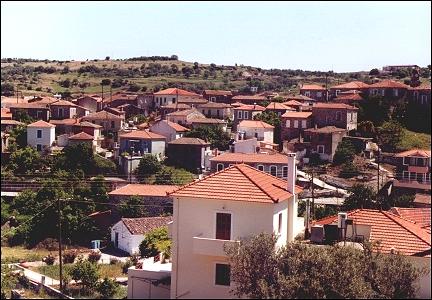 |
Immediately past Stipsi the road descends 400 meters, circling the mountain between rows of trees. Far below us we see the church of Petra on a steep rock. Near the port of Petra we have one more strenuous climb and then we see Molivos, on a cape behind a bay which shines in the afternoon sun.
When we arrive in Molivos (officially Mithimna) after 70 kilometers, we meet the bicycle racers again. They greet us with thumbs up. Below the village lies the small port, our destination. We are enjoying the view with a glass of ouzo, when we overhear a Dutch lady complain that she has to share the hotel with the bicycle racers: the constant click-clacking of 160 pairs of bicycle shoes on the stone floor drives her nuts.
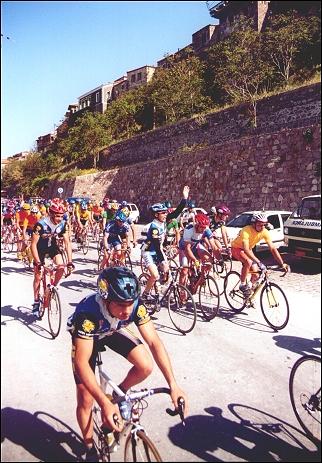 |
High up in the village we find a room in a house with a big flower garden. It's not easy to get our bikes there, the streets go up straight the steep rock. The last part is even with stairs.
After we have showered, the landlady brings us coffee on the balcony. She points out, far below us, the fishing boat on which her husband works. We have the best place in the house for the sunset. A little later, lights appear everywhere on the coast of Lesbos and nearby Turkey.
We climb to the castle via beautiful streets, through gates and along little squares. There isn't much more left than the walls and one gate, but because of its strategic location, the views are stunning in all directions: Molivos and its port, the sea, Turkey, the mountains from which we descended yesterday and the mountains we will climb tomorrow. Immediately below the castle entrance is an outdoor café with panoramic views, where we enjoy the view a little longer with drinks.
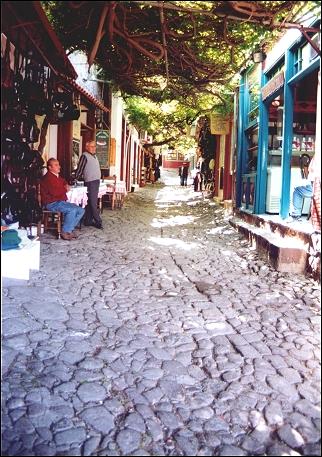 |
Molivos is a landmark village. And it should be, the alleys and streets with their cobblestones have completely retained their medieval looks. Between the natural stone houses with their red roof tiles and protruding upper floors you would think you were in Macedonia instead of on an island. Gates, tree-branches and grapevines provide some coolness.
The downside: the place has an artificial feel. Almost all stores and bars along the coastal road and on the wonderful Agora are catering to tourists. It's only early in May and we already hear as much Dutch as Greek. All accomodations for the tourist season are already booked up. Moreover, the village is a backdrop for all kinds of yoga, painting and other workshops. Add watersports, clubs and the visitore from nearby tourist resorts and the picture gets too crowded to be able to call this a dreamy village.
That being said, in the off-season it's still a pleasant enough place. Around the port are a few reasonably good restaurants. Captain's Table has nice snacks. Restaurant Nassos on the Kato Agora even has excellent food. Opposite Nassos, El Greco serves dessert and coffee with delicious pies.
We have coffee on the village square in Petra. It is a day of bicycling, so we don't have to hold back: breakfast with Schwarzwalder Kirschtorte. Petra is too developed to have any charm left at all, even though there are a few nice streets with old houses around the square. We find a bakery there where we get puff pastry filled with spinach, feta, sausages and ham with tomatoes as provisions for the ride.
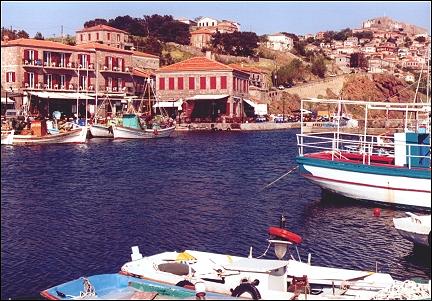 |
Today we leave the north of Lesbos for the west. Up to the Anaxos resort we ride parallel to the coast, but then the road climbs in a large loop to Skoutaros and then with a bend further inland.
On the other side of a valley that cuts deep into the mountains the road makes a short turn toward the sea. Far below us we see Molivos. Between rocks and olive trees the road winds over the hills of the Ilians Mountains. Via two ponds with loudly croaking frogs we arrive in Skalochori, located at an altitude of 300 meters in a bowl between mountain peaks. It's time for a break in the shadow on the square in this nice mountain village. On the road there is hardly any protection at all from the burning sun.
Shortly after leaving Skalochori we descend on a road with many hairpin turns into a beautiful green river valley. And of course: just after we cross a bridge, we have to climb up again. Vatouse is a crossroads surrounded by taverns. Past this village there's another awsome, long descent into one more green valley.
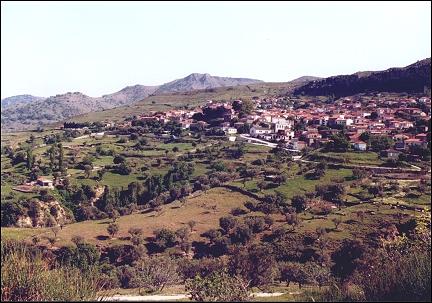 |
We are punished again for descending: a 100 meters climb with steep hairpin turns. On a green slope lies Andissa, to its left the mountain peaks get increasingly bare. Climbing another 150 meters in the scorching sun, we leave the greenery behind us again.
From the exit to Eressos it's up and down through a wonderful, wild mountain landscape. Only herbs grow between the bare rocks. We brake to let a turtle cross the road and then, without further interruptions, we descend on a road lined with broom into a long valley. Resting our legs, we enjoy the pretty landscape. At the end of the valley lies Eressos and from there it's only a few kilometers to the promenade of Skala Eressou.
Skala Eressou has no more than a few streets, devoid of charm. The promenade is flanked by pizzerias, English restaurants, Canadian pancake houses and hippie stores. It's hard to find a real taberna, but I Gorgona does Greece honor.
Eressos is the birthplace of the poetess Sappho and this has made the village into a kind of place of pilgrimage for lesbians. There are also many neo-hippies here. The main attraction is the sand beach, which is beautifully located between the foothills of the mountains.
We climb out of the fertile plain accompanied by wonderful views of Skala Eressou and the mountains surrounding it. Today we bicycle on the southern slopes of the mountain range we crossed yesterday on the north side. The next valley is surrounded by mountains with meandering stone walls up to the highest peaks. After our descent to a river follows the inevitable climb with hairpin bends.
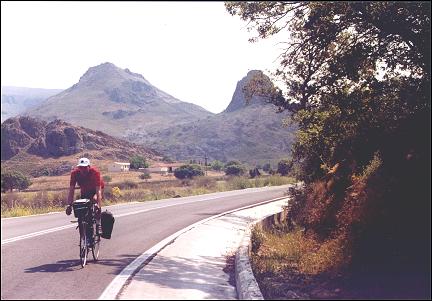 |
The landscape is still wonderfully wild, but the climb doesn't seem to end. Above Mesotopos the road turns and for a while it runs less steeply along the massif. To our right are fertile valleys, to our left bare slopes.
The road winds around a peak and then climbs to a mountain pass, flanked by two old windmills. From there we zip down through woods to Agra, a nice mountain village at 400 meters in a fold in the mountains. We recuperate in the shadow with iced coffee and sodas. And we are gathering courage, because on the other side of the valley we can already see the hairpin turns that we'll have to conquer later. But first we go 200 meters down.
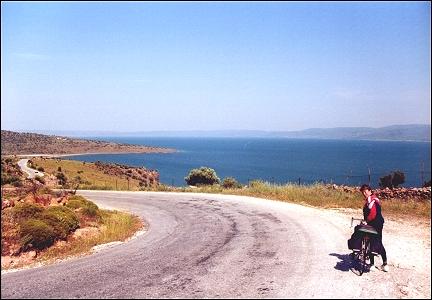 |
Once we are all the way up, the next descent looks better with slight bends and views of the entrance of the Gulf of Kallonis. One more small hill to round the cape and suddenly we find ourselves bicycling in a stunning moonscape with stone walls and large rocks.
At a hamlet on a river mouth we have to climb one more time, and then we descend until we arrive in Parakila at sea level. Slightly up and down we follow the coastline. The last part goes through a wet area with a lot of agriculture. Eventually we arrive in Skala Kallonis on a gravel path. When a pick-up truck pass us, we yell "Patatas, bananas..." by now we know what produce is most often recommended thorugh the loudspeakers on the roof.
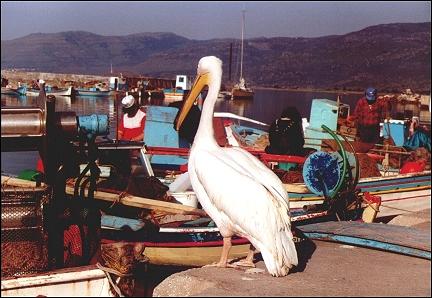 |
Skala Kallonis lies around a fishing port, where a pelican forages between the little boats. In an alley next to the platia is a diminutive bakery that sells bread straight from the oven.
On the edge of the village is a pond where birdwatchers lie in wait. You find them and their binoculars everywhere on Lesbos.
Skala Kallonis has nothing to offer except its beach, behind which lies a plethora of hotels, B-and-Bs, and apartments. We can't resist the lure of the cool water and insert a beach day despite the surroundings. On the other side of the bay we again see Mt. Olympus. High on its slopes lies Agiassos, a beautiful mountain village, unfortunately overrun by tourists.
With a view of a row of salt lakes we ride along the Gulf of Kallonis. Only after 10 kilometers we have to climb when the road turns inland.
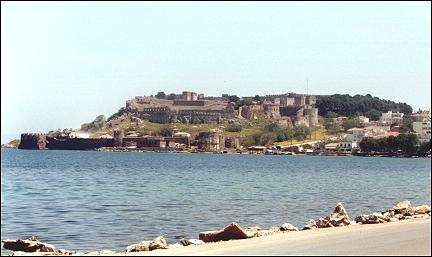 |
It's incredibly hot. Again. During the descent we take a break for drinks in Lambou Mili, looking over the Gulf of Geras far below us.
We descend in a curve between a high rock and the Gulf and after a short climb between olive groves we arrive at the east coast via Moria. A little later we pass an ouzo distillery and a castle ruin and then we are in Mitilini. The ferry that will take us to Chios tonight is already waiting in the port.
Chios
Medieval looking mastic villages
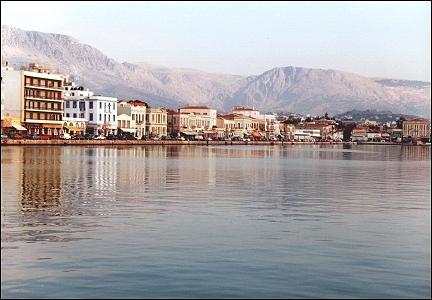 |
While the ferry sets course to Chios, sailing close to the Turkish coast, we see the sun go down from our position on the afterdeck. In the port of Chios City the gigantic ferry towers over the little houses. We pick up our bicycle from the hold and walk onto the landing.
When we return to the port the next morning, we see bare mountains rise behind the houses. In the north corner of the port is the agora, with countless little shops on narrow streets that lead to the city park. Just behind the park is Porta Maggiora which leads with a few bends to the kastro district which lies behind high walls. It is a maze of little streets with mostly seriously delapidated Turkish houses.
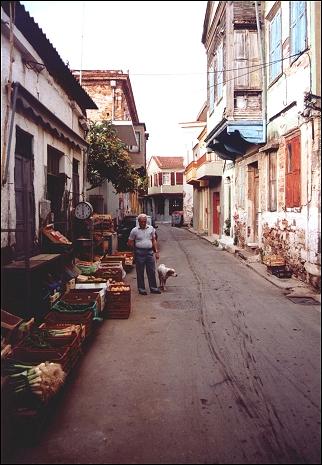 |
Around noon we leave Chios City on the road along the airport and ride to the Kambos. This is a more or less level area around the city where there are supposed to be old villas between Genoan walls. But we see mainly new developments between the walls.
After only a few kilometers we climb out of the plain via slopes overgrown with olive trees. When we have reached the top at 300 meters, we almost fall into the next brook valley: the hairpin turns seem glued to a perpendicular wall. The valley and slopes are yellow with broom. When we have crossed the brook, a 150 meters lower, we immediately begin to climb again.
When we descend through Armolia, we are already in the region of the mastic villages. We already passed the first plantations with mastic (plant resin) trees. It looks as if waterdrops are hanging from the trees - the stuff is aptly called "Tears of Chios" in Greek - but it is transparent resin that turns white when it dries.
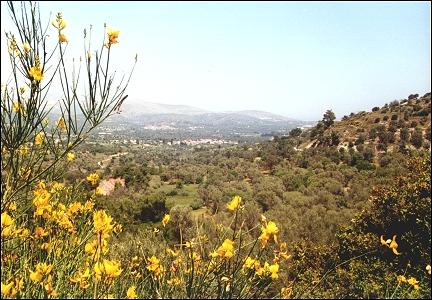 |
Nowadays the resin is used for chewing gum and liqueur but in the past there were many more applications and the production of mastic was very lucrative. Because of the many pirates in the Mediterranean the villages - which were built in the 14th century by Genoan colonists - look like fortresses.
Later mastic chewing gum became very popular in the harems of the Turkish sultans, because it masks bad breath. When the Turks murdered thousands of Chiotes and destroyed their villages in 1822 as retaliation against the Greek struggle for independence, they left the mastic villages unharmed because they didn't want to jeopardize the production. Because of this, only these villages have retained their medievel character.
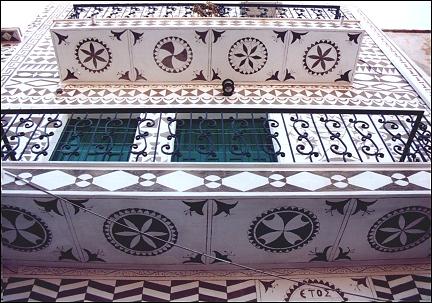 |
From Armolia it's only a few kilometers up and down the hills and then Pirgi lies before us in the afternoon sun. I can't suppress a grin: it exceeds all expectations. Almost all houses are decorated with grey-white patterns.
These xysta make the village unique. The houses are plastered with volcanic sand from the surroundings and then plastered with white. While the plaster is still wet, the decorations are carved. In these spots the grey volcanic layer is revealed.
We are in a maze of sreets, gates and dead-end alleys, meant to trap attackers, and look for a way to get to the town center. Fortunately contemporary visitors are helped with the signs "center" and "exit". On the platia we first have a beer while letting the surroundings sink in. This is amazing. Even the church is decorated from top to bottom.
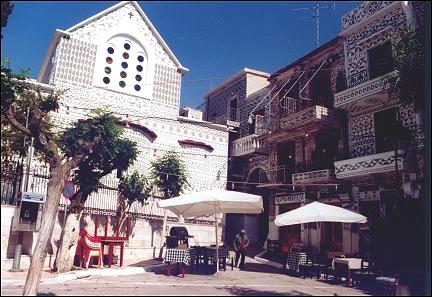 |
Of course the waiter knows where we can find a room. He takes us to a little shop around the corner, where Rita sells cigarettes, candy, souvenirs and other stuff.
Holding a large ring of keys, Rita leads the way to a house which rooms she rents out. We get a room with a high, vaulted ceiling, it looks like a church hall. The roof terrace looks out over the village.
We are sure we can get a meal in the big tavern on the corner of the platia. The owner laughs a big, cheerful laugh when we say so. Yep, in the past that was possible. Now he is wiser and only serves drinks. Cooking, he tells us, is way too much work. He points out a diminutive place on the other side of the square: those people love working hard and they make excellent food.
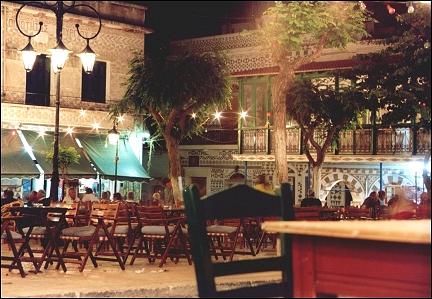 |
He doesn't exaggerate. The owner greets us enthusiastically and immediately sends us to the kitchen, where his wife lifts the lids off the pans and opens the door of the refrigerator to show us what they have.
One table over sits a man with whom we had a conversation on the way, just outside Chios City. He immediately orders a large bottle of retsina, Greek resin wine. He used to be a sailor, like so many Greeks, but nowadays you can't earn a living that way. Only on the bridge there are still Greeks, the other crew are from poor countries like the Philippines.
While the owner of the restaurant and his wife work their butts off, we watch the village life on the beautifully illuminated fairy-tale square. The later it gets, the busier. Now that it's cooler, playing children appear everywhere. One outdoor café is filled with families, the next one is occupied by teens, and all others are the territory of old men with little glasses of booze, who keep an eye on everything. There's a constant stream of mopeds and cars, which frequently stop to chat with an acquaintance or to let ball-playing and bicycling children pass. It looks like an old Italian movie.
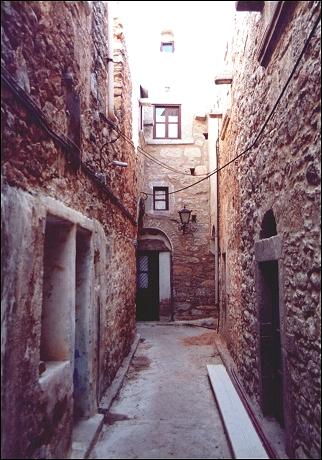 |
Via Olimbi, a languid village with many donkeys roaming free, we bicycle over tough hills with mastic trees to Mesta. The backsides of the houses form a closed front to double as city walls. There are only a few entrances to the village.
Where Pirgi looks like a happy place, because of the xysta, Mesta reminds us of the expression The Dark Ages. The grey stone houses are so tall that the sun hardly reaches the narrow streets. Most alleys are so narrow that we just manage to walk through them with our bikes. The gates follow one after another, making it look at times as if we are in a tunnel. Most alleys have dead ends, but also here signs show the way.
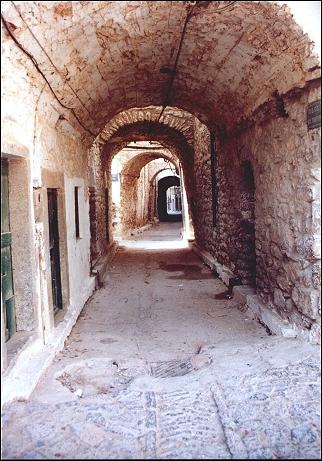 |
The contrast couldn't be sharper: the atmospheric platia is bathing in sunlight. There are trees and the balconies of the surrounding buildings are filled with plants. There's a large church. Stairs lead to a light-filled portico with painted archs, which looks on the square. The square is covered with chairs and tables, catered to by two taverns.
On the way back to Chios city we take a coastal route. We climb via Kalamati to Patrika; two kilometers further we reach the top, where we have views of the sea and Turkey. We descend into a valley with rural villages, chapels and monasteries.
The coastal road goes up and down until the final descent to Kambos begins at a large monastery. We whizz past pretty low walls behind which we now see and old villa between citrus plantations every now and then. A little later we are on the promenade in Chios City, where we will board the ferry to Samos.
Samos
Beautiful green mountains rides and tourist resorts
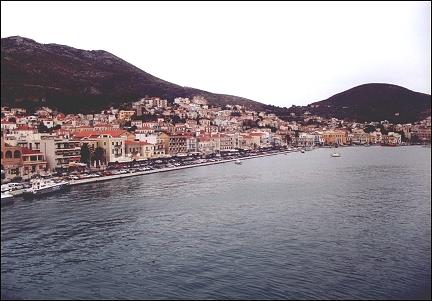 |
The ferry that takes us from Chios to Samos is small. Still, when we arrive in the evening, a group of people desperate to rent out their rooms is awaiting us on the landing of Vathi (Samos City). We rent a room in a higher lying part of the city, which means we have to drag our bikes up numerous stairs. On our terrace we have a view of the port.
The next morning we first buy tickets for our next ferry. Unfortunately it's no longer possible to get a direct connection to Paros or Naxos. Last week those services were stopped and we have to go to Mykonos first. The shipowners do as they please, sighs the woman who sells the tickets.
We planned to ride along the north coast of Samos to Karlovassi and take a ferry there. But it's cool with a strong wind, so we change our minds. All of a sudden we have the whole day to explore Vathi. It's no small task to get through the day. Only the higher lying Ano Vathi is worthwhile. On top of that, the city is flooded with tourists who flee their beach resorts today. And the interesting archeological museum with, among other artifacts, a meters-high kouros, is closed on Mondays.
We are glad when we can tie our bikes to the side of the car deck on the ferry at the end of the afternoon and leave the port. On the green coast we see the white houses of Kokkari. A fellow passenger tells us that only ten years ago this was a charming fishing village. Now it's hard to even find the village between the developments; the streets are littered with picture-postcard racks with "naughty" postcards that are supposed to send people greeting from Samos. No need to spell out what kind of tourists you find there.
Samos still is one of the greenest islands, but the north coast was terribly damaged by huge forest fires. One third of the forest burned down. Just before the bare massif of the 1,433 meters high Mt. Kerkis the ferry turns and enters the port of Karlovassi.
Ten days later we dock here again, after a visit to the Cyclades. This time we don't arrive in the evening, but at 4:30 AM, after a night of looking at the stars and the lights on the islands we pass. Everywhere on the ferry people are sleeping: on benches, between chairs and even in the aisles. Fortunately there's a place in Karlovassi's port that serves coffee 24/7. Sitting behind cups of sweet Greek coffee, we see the ferry disappear in the night.
Around 5:30 AM it's light enough to hit the road carefully. Karlovassi isn't much to speak of. Around the port are some pretty houses, the rest is dominated by a delapidated industrial zone. Umbrellas and beach chairs stand in straight rows under palmtrees on the cheerless beach. A few kilometers inland it gets better, the houses here have colorful flower gardens. The town is waking up already, people are getting to work. Many of them are soldiers, like everywhere on the East Aegean islands close to the Turkish coast. Every few kilometers we see a sign "Photographing is prohibited".
Just outside Karlovassi the road climbs steeply up through a forest. To our right we see two mountain villages disappear below us. The forest fire has done a lot of damage here, too. Except on Mt. Kerkis which towers over the island, because the mountain was bare already. Kerkis is a popular hiking destination, but the inaccessible looking slopes are not without danger. People frequently get in trouble and need to be pulled out by helicopter. Some years ago help came too late for a Dutch priest.
It's already scorching hot at 8 AM. Fortunately we have already reached the highest peak (380 meters) and are starting our descent below a row of modern windmills.
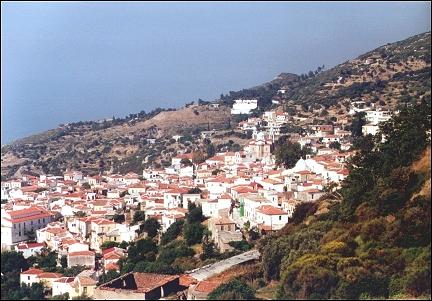 |
A series of hairpin turns brings us to Marathokambos, not a very special village, but beautifully located at 250 meters against the mountain and with a view of a large bay far below us.
Past Marathokambos the hairpins aren't over yet. The narrow, bad road keeps descending for kilometers. Woods are increasingly giving way to agricultural landscapes, in which olive trees dominate as usual. Eventually we arrive in Ormos Marathokambo on the coast.
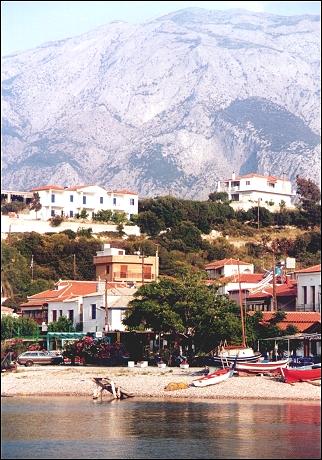 |
Ormos has a nice fishing port. Behind the village rise high mountains on all sides. There are sand beaches nearby, so there is touristic development. It still isn't mass tourism, but it's already hard to find a taberna that serves real Greek food between the pizzerias. Leftaki turns out to be a good choice. Over the delicious mixed grill I stare at the mountains we will have to conquer tomorrow.
The road from Ormos to Koumaika isn't by far as good as the room owner suggested. Every now and then there is some asphalt, but it never amounts to more than 100 meters around a difficult turn. And soon the coastal plain isn't level anymore either. Behind us we have a great view of Mt. Kerkis and Ormos, which slowly disappears below us while we struggle between yellow broom, olive trees and poppies.
Just before we reach Koumaika the road is finally asphalted for real. Koumaika is a nice mountain village. We have coffee in the shade of a huge planet-tree. An old man with a bread tucked under his arm shuffles to our table and cadges a cigarette.
The road slowly winds up the mountain toward an open mine high on the mountain slope. The houses in Komeika become smaller and smaller dots and also Marathokambos and the windmilles lie deep below us meanwhile.
The landscape gets greener and past the mine we bicycle into a dark forest. Immediately we are rid of the wind gusts. There are little shops along the road that sell farm produce: honey, herbs and olive soap. Between terraces seperated by stone walls olive trees sparkle in a fairy-like light.
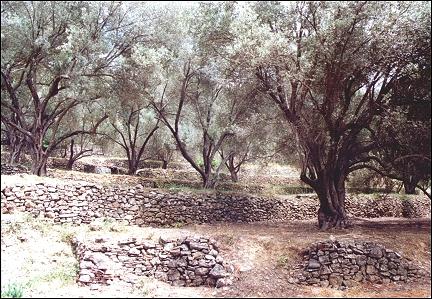 |
Past the pass at 600 meters we reach Pirgos, which lies at the end of a very deep gorge. The road goes nicely up and down to Koumaradeii, a pottery village.
On a slope on the other side sits a big monastery, and far below us we see the Pythagorio plain. As we follow the road which meanders downward, we see the airport. The last few kilometers are almost without bends and our descent goes fast. Only a traffic light stops us. Soon we arrive in Pythagorio.
Pythagorio has a few highlights, among which the 1.5 kilometers long Eupalines tunnel, which was constructed in the 6th century BC to bring water to the town.
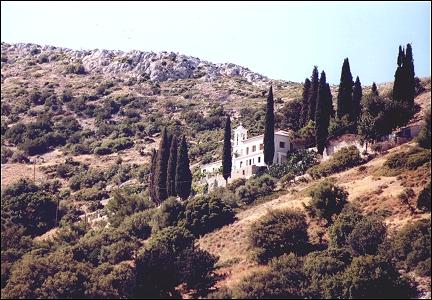 |
There also are a lot of excavation sites, none of which is spectacular. A few kilometers further is Ireo, a Hera sanctuary of which only one column still stands.
Samos is one of the most popular tourist destinations among the Greek isles, and the airport, where during the summer season dozens of charter flights spit out their passengers every day, lies just outside Pythagorio. And Pythagorio has beaches, so it shouldn't be a surprise to find a Dutch restaurant on the promenade. It's already crowded enough in May for the main street to be closed off to traffic around the time the masses return from the beach. Fortunately we go home tomorrow, so Pythagorio won't get a chance to drown out the memories of the beautiful route that took us here.